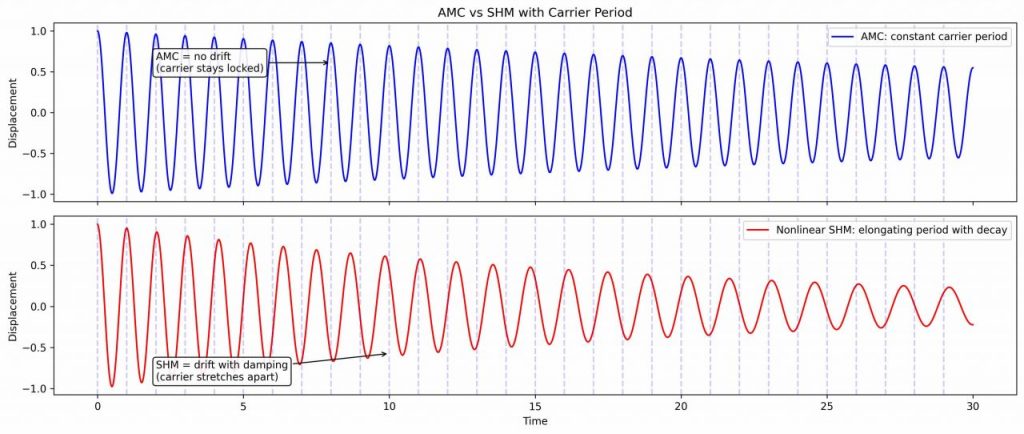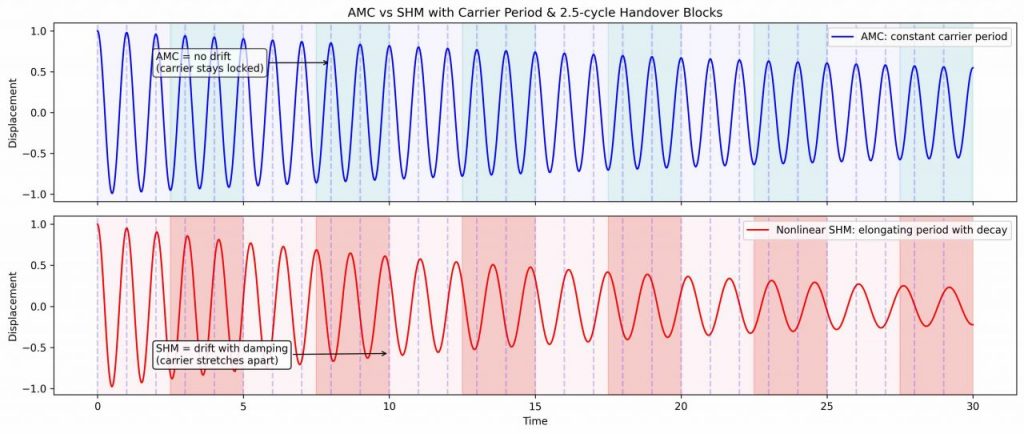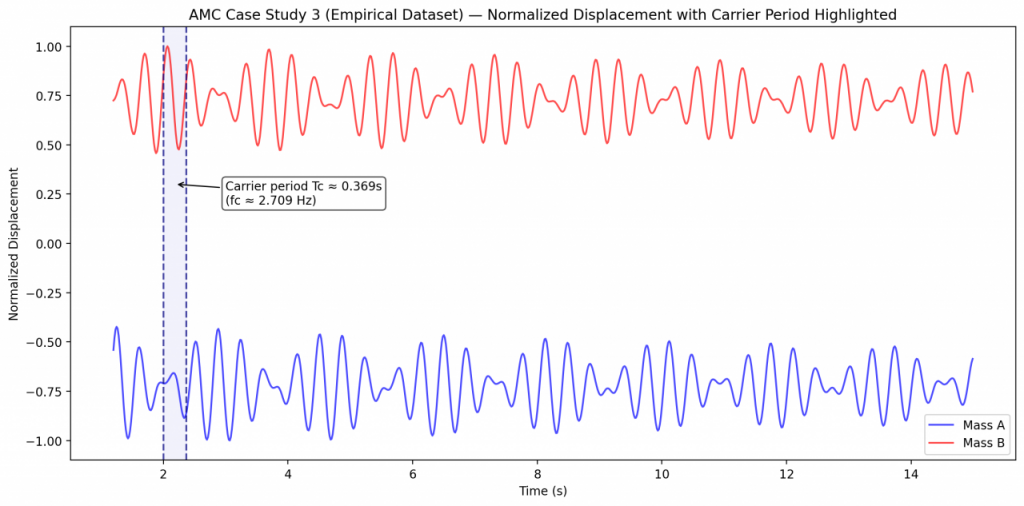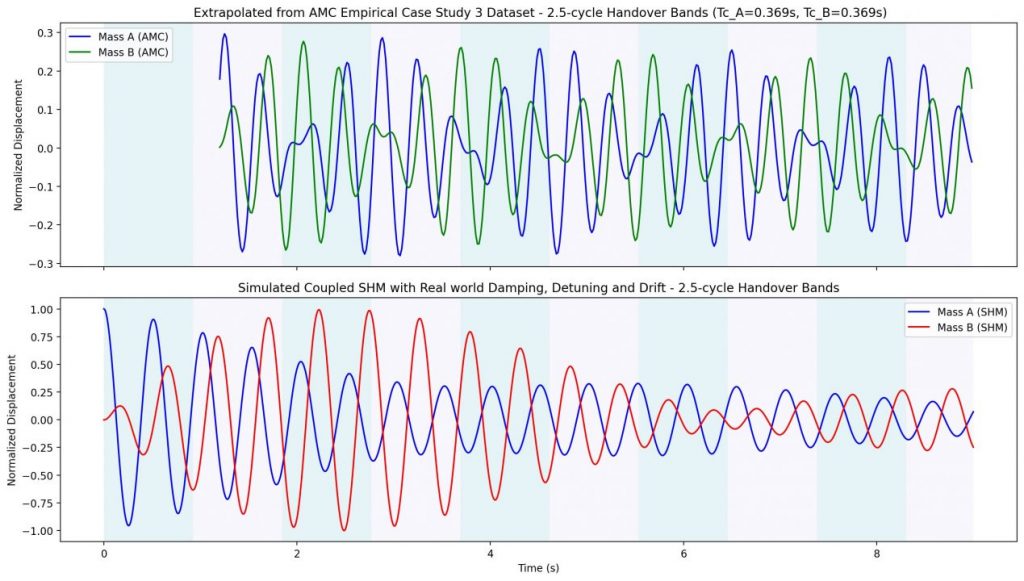This website uses cookies so that we can provide you with the best user experience possible. Cookie information is stored in your browser and performs functions such as recognising you when you return to our website and helping our team to understand which sections of the website you find most interesting and useful.
Welcome to the official scientific archive and discovery portal for the Active Magnetic Cradle (AMC) — a groundbreaking, experimentally validated system uncovering new principles in oscillatory physics that could be used to reshape: Energy, Computation, Environment, etc.
⛏ Groundbreaking Physical Behaviour 🎯
What is Active Magnetic Cradle (AMC)?
AMC is a new class of oscillatory system that combines gravitational forces and magnetic interactions in a pendulum-like cradle.
Unlike most pendulums which obey simple harmonic motion (SHM), where oscillations gradually elongate and decay, AMC produces a repeatable oscillation pattern shaped by both gravitational potential energy and magnetic repulsion.
The oscillations repeat like a steady drumbeat from beginning to end, a precision typically absent in passive mechanical systems, but often studied in quantum oscillators where phase timing and energy memory are tightly structured.
The result is a level of phase-timed precision rarely seen in passive mechanical systems, combined with a phase-symmetric, constant-period oscillation and structured energy handovers that diverge clearly from SHM predictions.
AMC represents the first experimentally validated deterministic oscillator where magnetic field dynamics and classical pendulum motion combine to produce a stable carrier period with quantized energy transfer.

🔄 Universal Oscillation Behaviour ↔️
AMC Retains Consistent Carrier Periods
AMC maintains a constant carrier period across amplitude decay, unlike Simple Harmonic Motion (SHM )where the carrier elongates with damping.
AMC vs SHM: Carrier Period Stability
AMC represents the first experimentally validated mechanical oscillator that retains a constant carrier period as amplitude decays without external energy input.
In classical damped Simple Harmonic Motion, amplitude decay is accompanied by a gradual lengthening of the period.
Electronic oscillators can approximate constant-period decay, but they require active feedback or externally supplied energy. AMC achieves the same stability purely through its gravitational–magnetic configuration. This sets it apart as a unique deterministic oscillator, bridging magnetic field dynamics with pendulum motion in a way not captured by SHM.

🪐 Constant repeating pattern 🌐
AMC Repeats Deterministic Energy Exchanges
AMC locks oscillations into deterministic 2.5-cycle handovers, unlike SHM where periods drift with damping.
The ~2.5-Cycle Energy Handover
In AMC, oscillations repeat with a ~2.5-cycle handover pattern. This means that energy consistently transfers after every ~2.5 carrier periods (as shown in the blue background shading). The exchange is deterministic and phase-locked, persisting even as amplitude decays, behaviour not found in classical SHM.
Whereas coupled SHM systems tend to drift or become irregular, AMC maintains fixed timing across all handovers. This marks AMC as the first experimentally validated mechanical oscillator where gravitational and magnetic forces combine to quantize energy transfer into repeating handover blocks.
In classical SHM, coupled oscillators drift unpredictably, often leading to chaotic exchanges. By contrast, AMC’s transfers remain locked at ~2.5 cycles, pointing to a deterministic structure. In experiments, this appears as wavelet patterns, which we explore in the next section.

〰️ Wavelet Oscillations 〰️
AMC: Deterministic Wavelet Oscillations
Carrier period stability reveals repeating wavelet bands in AMC oscillations.
HOW AMC’S WAVELETS DEFY CLASSICAL EXPECTATIONS
Classical SHM predicts that oscillations should slow and stretch as amplitude decays.
AMC instead shows a fixed carrier period at each scale (for Case Study 3 ≈ mean carrier period Tc ≈ 0.333 s to Tc ≈ 0.369 s), producing a repeating wavelet framework. This framework is consistently formed by ~2.5-cycle handovers that repeat without drift, revealing a quantized, field-locked oscillatory regime.
High-speed measurements confirm that AMC’s oscillations do not elongate with damping, but remain tightly bound to deterministic wavelet bands. This means AMC operates as a stable, quantized oscillator rather than a decaying SHM system.
In short: AMC doesn’t just oscillate — it creates wavelet packets of energy that remain synchronized, predictable, and reproducible within each configuration.

Wavelet Predictability ⚙️
AMC: Deterministic Wavelet Predictability
AMC locks oscillations into repeatable 2.5-cycle handovers, unlike SHM where damping introduces drift and unpredictability.
WHY AMC DISPLAYS PREDICTABILITY?
Classical SHM loses predictability as damping stretches oscillation periods and causes irregular phase drift between coupled masses.
AMC instead maintains deterministic handovers: energy consistently transfers after ~2.5 carrier cycles, locking oscillations into repeatable wavelet bands. This field-mediated coupling means oscillations remain stable and synchronized, even as amplitude decays.
At higher resolution, AMC’s wavelets reveal something deeper than a single fixed Tc. Measurements show that handovers alternate between slightly different Tc values (in Case Study 3 this is between ~0.333 s and ~0.369 s), producing a nested “superperiodicity” that resets coherence (in Case Study 3 this is between this is every ~4–5 Tc blocks). This behavior is unlike classical coupled oscillators: instead of drifting apart, AMC resets itself in quantised steps. We interpret this as a form of temporal quantisation, where oscillations are governed by both the fundamental Tc and higher-order multiples that regulate symmetry.
The result is a system that doesn’t just oscillate, it generates predictable, reproducible wavelet packets of energy. This repeatability opens the door to practical applications in sensing, timing, and energy transfer, where reliability and determinism are critical.
In SHM, damping causes oscillations to stretch and drift.
In AMC, every ~2.5 cycles repeat with clock-like precision, making its wavelets deterministic, synchronized, and reproducible.

🚫 DOCUMENTS RESTRICTED DURING PEER REVIEW
AMC Carrier Period Analysis is under peer review, meanwhile to focus on this documentation only related documents are available for public access.
Selected datasets and law documents may be shared privately upon request with qualified researchers or reviewers.
Technical Detail and Scientific Traceability of AMC
⛏ Groundbreaking Physical Behaviour 🎯
Several breakthrough findings emerged from repeated experimental trials, multi-angle video tracking, simulation overlays, and comparative waveform analysis. While theoretical models were developing in parallel, Phase 1 remained observationally grounded, documenting consistent behaviours across small-scale and large-scale physical systems.
Scientific traceability of the Active Magnetic Cradle (AMC) research (2023–2025) focused on empirical validation of macroscopic oscillatory behaviours in magnetically coupled pendulum system patented as Repelling Magnetic Instrument (GB2614887).
Active Magnetic Cradle Governing Behaviour Research Paper
This paper explores the governing behavior of the Active Magnetic Cradle (AMC) system, focusing on its oscillatory dynamics, energy transfer, and time symmetry properties. The system utilizes magnetic coupling and various gravitational forces to produce sustained oscillations, and this study investigates how these oscillations behave under different conditions, including theories for experiments in environments with low electromagnetic fields, as predicted in Quantum Field Theory (QFT). The research introduces memory kernel models to analyze the system’s energy retention and time-symmetry behavior. Results suggest that the AMC system can be used to study real-time energy transfer, with implications for space-based energy systems, quantum physics, and time-reversal symmetry.
🔗 GitHub AMC Governing Behaviour Research PDF
🔗 https://doi.org/10.5281/zenodo.17184527
📄 Zenodo · Preprint · PDF · 2025
Law 1: AMC Oscillation
Defines the unique harmonic motion of AMC systems, where coupled oscillators follow stable, non-classical energy pathways unlike simple pendulums.
🔗 https://doi.org/10.5281/zenodo.15320379
📄 Zenodo · Preprint · PDF · 2025
Law 2: AMC Wavelet Memory
Demonstrates that AMC wavelets retain structural memory over time, resisting classical damping and preserving energy transfer integrity.
🔗 https://doi.org/10.5281/zenodo.15337545
📄 Zenodo · Preprint · PDF · 2025
Law 3: AMC Spiral Decay
Reveals that energy decays in spiral-shaped envelopes, not exponentially — indicating deeper geometric structuring within AMC dynamics.
🔗 https://doi.org/10.5281/zenodo.15338615
📄 Zenodo · Preprint · PDF · 2025
Law 4: AMC Reverse Predictability
Confirms that both past and future oscillation states can be deterministically reconstructed from current wavelet data.
🔗 https://doi.org/10.5281/zenodo.15338685
📄 Zenodo · Preprint · PDF · 2025
Law 5: AMC Temporal Symmetry
Proves AMC systems behave time-symmetrically at the wavelet level, defying classical thermodynamic directionality.
🔗 https://doi.org/10.5281/zenodo.15345198
📄 Zenodo · Preprint · PDF · 2025
Law 6: AMC General Motion
Unifies all aspects of AMC oscillatory motion into a single coherent model, covering displacement, velocity, amplitude, and timing.
🔗 https://doi.org/10.5281/zenodo.15345581
📄 Zenodo · Preprint · PDF · 2025
Law 7: AMC Cycle Handover Constant
Identifies a universal constant: AMC systems consistently transfer energy after ~2.5 oscillation cycles between magnets.
🔗 https://doi.org/10.5281/zenodo.15870950
📄 Zenodo · Preprint · PDF · 2025
Law 8: AMC Phase Decay
Shows that amplitude loss occurs along stable, coherent phase boundaries — not through random frictional decay.
🔗 https://doi.org/10.5281/zenodo.15868098
📄 Zenodo · Preprint · PDF · 2025
Law 9: AMC Field Oscillation Coherence
Demonstrates that AMC systems maintain phase coherence via magnetic field alignment, even in asymmetric setups.
🔗 https://doi.org/10.5281/zenodo.15866163
📄 Zenodo · Preprint · PDF · 2025
Law 10: AMC Wavelet Quantization
Discovers that energy is transferred in discrete wavelet packets — forming quantized, logic-like energy states.
🔗 https://doi.org/10.5281/zenodo.15865732
📄 Zenodo · Preprint · PDF · 2025
Law 11: AMC Fractal Memory Geometry
Finds nested fractal structures within AMC oscillations, suggesting recursive energy symmetry across time scales.
🔗 https://doi.org/10.5281/zenodo.15864629
📄 Zenodo · Preprint · PDF · 2025
Law 12: AMC Dynamic Resonance Logic
Reveals that input energy levels control access to specific resonance bands — forming a field-based logical gating system.
🔗 https://doi.org/10.5281/zenodo.15794893
📄 Zenodo · Preprint · PDF · 2025
Law 13: AMC Symmetry-Deviation
Shows AMC behavior remains stable even with physical imbalance, suggesting that symmetry is governed by field logic, not mass matching.
🔗 https://doi.org/10.5281/zenodo.15779123
📄 Zenodo · Preprint · PDF · 2025
Law 14: AMC Energy Ladder Hysteresis
Identifies that energy transitions occur in stepped bands with hysteresis-like memory effects between layers.
🔗 https://doi.org/10.5281/zenodo.15778565
📄 Zenodo · Preprint · PDF · 2025
Law 15: AMC Superposition
Confirms AMC wavelets can stack non-destructively, supporting simultaneous oscillatory states — a macroscopic form of superposition.
🔗 https://doi.org/10.5281/zenodo.15588191
📄 Zenodo · Preprint · PDF · 2025
AMC Law Compendium
AMC LAW COMPENDIUM
This paper explores the physical deviations and contradictions to classical assumptions documented while examining Active Magnetic Cradle (AMC) system. AMC oscillatory dynamics determines new ontological pathway for physics.
📄 Zenodo · Preprint · PDF · 2025
Active Magnetic Cradle Field-Structured Thermodynamics
This white paper explores a theoretical extension of thermodynamics in the context of the Active Magnetic Cradle (AMC), proposing that oscillatory systems exhibiting phase-synchronized, temporally quantized energy exchanges may give rise to field-structured thermodynamic gradients. It suggests a novel interpretation where coherent wavelet propagation and phase coherence in AMC systems form structured entropy gradients, distinct from classical thermodynamic chaos. The study lays the groundwork for treating AMC oscillators as structured thermodynamic entities capable of computing or guiding energy flow, potentially redefining entropy and order in macroscopic quantum-inspired systems.
🔗 https://doi.org/10.5281/zenodo.16238290
📄 Zenodo · Preprint · PDF · 2025
Active Magnetic Cradle Supplementary Methods & Reproducibility Appendix
AMC Supplementary Methods & Reproducibility
Instructions to recreate AMC motion caused by coupled magnetic pendulum oscillation.
🔗 https://doi.org/10.5281/zenodo.16238264
📄 Zenodo · Preprint · PDF · 2025

